In her review of The Wages of Fear (1953), Paul Kael defined the film as an “existential thriller”. This perfect description of the premise’s spin on the thriller genre encapsulates why this film remains so compelling, so dramatic, and so provocative after so many years. Moreover, the fact that The Wages of Fear inhabits this singular space within the genre warrants further examination into how this distinctive film manages to expand this simple premise into a complex, spellbinding study into the nature of man’s relationship to fate, as seen through some of the most thrilling sequences to ever be engraved upon the silver screen.
Opening with a shot that would be reappropriated by Sam Peckinpah for his opening of The Wild Bunch, Cluzot’s The Wages of Fear begins with the stark image of a child toying with four scorpions within the poverty-stricken South American town of Las Piedras. When the boy becomes momentarily distracted by the promise of an iced treat that he can’t afford, a vulture swoops down to steal the scorpions—instantly establishing this savage setting to which these characters and premise must survive. Those characters are found in four men of different nationalities, who share the bond of being men crushed by the cruel hand of fate and now imprisoned within this inescapable town to bleak lives of despair.
The “protagonist” and first man to be introduced is Mario (Yves Montand). Though few details of his backstory are revealed (an enormous distinction in comparison to William Friedkin’s adaptation of the same source material in 1977’s Sorcerer), his fate as a cold, condemned man becomes quickly evident. He treats the cantina girl—Linda—with zero respect, and though clearly a capable man, seems resigned to the disastrous turn his life has taken.
His Italian roommate—Luigi—stars as the second of the four. An honest and hardworking man with a more optimistic outlook, though his lung cancer diagnosis quickly changes his perspective. The third and most intriguing backstory is found in the German—Bimba—a hardened man forced to work the Salt Mines during the Nazi occupation of his country. The final of the four men is introduced in an ex-gangster—Jo—who bribes his way into town and quickly becomes aware of the fatalistic undercurrent that permeates the province and transforms its citizens into prisoners.
Ruling over the village and advertising a chance for escape is the Southern Oil Company. When an inferno erupts over distant oil fields, the Oil Company offers a glimmer of hope in the form of a near suicidal mission. This job entails the employment of four men—two in each truck due to the low odds of survival—that must deliver packages of highly explosive nitroglycerine that will extinguish the inferno consuming a distant oil field.
Knowing that they may very well die but realizing that this opportunity may be their only chance for survival from the arguably worse fate of continuing their interminable lives in town, the four set out on their quest filled with a constant sense of danger in the most literal sense imaginable. With the nitroglycerin onboard the truck, the slightest bump or impact of the volatile substance means instantaneous death. Still, the men accept their job and the consequences of failure, then begin their long drive through the rocky terrain.
The second half of the film depicts this arduous journey in excruciating, powerful cinematic display. The four men are divided into two teams tasked with driving their separate trucks: Mario and Jo in the first, Bimba and Luigi in the second. Though Jo has initially presented himself as a man of bravado and confidence, his disposition alters immediately upon the start of this fatalistic trip. He complains of sickness, weariness, hunger…all things that Mario recognizes as telltales signs of a rattled man, though he knows that they must persist forward and keep to schedule at all costs.
The first obstacle that the two trucks encounter appears in a rocky stretch with recently laid concrete that necessitates their needing to accelerate to top speeds in order to clear. Though Bimba and Luigi are able to successfully speed over this stretch, Jo again reveals his insecurities and brakes just before he has been instructed to drive at a top speed in order to clear the pavement —a move that nearly costs the lives of both him and Mario in this very early stage. Mario takes over the wheel from his fearful friend and manages to navigate them over this volatile ground.
Cluzot modulates the tension of this scene to masterful effect—a skill that will be demonstrated throughout the second half to even more remarkable power. Their needing to clear this road at a maximum speed despite the explosives in their trunk causes the viewer to grow uneasy with every shot that fixates over the speedometer and Jo’s reaction shots of nervous anxiety that mirror the audience’s own anticipation for disaster— creating a scene that serves as a model for cinematic tension at its best.
And it’s worth noting that this is only the first obstacle of the very long journey.
Luigi and Bimba soon encounter the second obstacle: a construction barricade that requires the truck to be gently steered across a flimsy, wooden platform that borders a precipice overlooking a cliff. Though again, the two are able to cohesively work together in order to cross this second sure sign of certain doom, their success has come at the cost of destroying the wobbly planks that allowed their first truck to clear the pass.
While the first set piece creates a feeling of fast anxiety, this second obstacle conjures that of subtle, mounting dread. As Jo directs Mario in his steering the wheels over the most dangerous three-point-turn that has ever been dared, the latter eventually realizes that the former may have fallen off the cliff. With the truck standing on creaking boards that hint at collapsing from the truck’s heavy weight at a moment’s notice, Mario hops out the truck and searches for Jo—only to find his companion hiding amongst the bluffs and fleeing the site.
Throughout this sequence, Cluzot wrings the viewer through a heightened level of anxiety that seems nearly impossible to top. As the audience has already watched Bimba and Luigi barely surmount this wobbly platform, the task seems all but impossible for Jo and Mario to successfully cross these already moldering boards that threaten to collapse under the slightest weight. Nonetheless, the viewer must sit and suffer through this dreaded set piece of merciless tension—a secondary model for cinematic tension materialized through one of escalating dread that contrasts from that of the extreme exhilaration seen in the first obstacle.
Yet, the two still manage to somehow conquer this second perilous stretch. Incensed by Jo’s betrayal, however, Mario drives away—leaving Jo stranded in the cliffs, until the cowardly gangster finally relents. Jo runs along the side of the truck, begging for Mario’s help, which the driver agrees to—having now humiliated the former gangster of bravado into admitting his cowardice.
The four drivers finally reconvene at their third, most immobilizing obstacle—an enormous boulder in the middle of the road that brings their convoy to a standstill. Though the group grows despondent in figuring out how to surpass this boulder, Bimba cleverly realizes that they may be able to use the nitroglycerin itself to detonate the rock and clear the path. Though they succeed in doing just that, another moment of acute, much more extreme tension arises when they realize that they may not have backed up the trucks far enough from any flying debris that would cause certain explosion upon impact. Luckily, the falling debris manages to miss the trucks and the quartet survives.
Still, this is yet another example of Cluzot expertly finding ways to differentiate the existential fear at the heart of the premise and find innovative ways of reworking this anxiety into various obstacles which arise along this journey in the form of plot. While the former two obstacles were ones in which the protagonists could somewhat calculate the danger—meticulously navigating their ways across landscapes that warned of the terror ahead—the flying debris represents the first instance of unknowable danger that arrives before the characters may be able to combat or avoid the consequences of their fate.
Of course, this alludes to the larger metaphor for death that saturates the entire film—the idea that man may be able to avoid avoid certain dangers, but an awareness that there are various agents of fate over which a man can have no control and may only escape through sheer luck—as these characters do.
This idea is further outlined to even more haunting effect in the ensuing scene. After driving past the boulder, Luigi commends Bimba on his heroics and so fearlessly confronting the problem through the use ofthe nitroglycerin. Bimba chuckles, then hints toward the horrors found in his backstory of working in the salt mines while living under Nazi regime. This then sets up Luigi’s next question, as to why Bimba continually shaves every day, to which the latter further explains that before his father’s hanging, he asked to take a shower. Finishing the explanation with: “If I’ve gotta be a corpse, I want to be…presentable”.
Moments later, back in Jo and Mario’s truck, the former has begun rolling a cigarette, when the tobacco suddenly rolls away. A blinding white light blazes in the aftermath, and the two slowly realize in horror as to the source of the searing light:
That Bimba and Luigi’s truck has exploded.
Despite their working together, despite their overcoming obstacles in their path, a sudden bump in the road has now caused their companions’ instant incineration. While the flying debris of the boulder represented a new manifestation of existential terror, the tension charging every inch forward on their journey after this deathly detonation perhaps best outlines the true terror found in this allegory of unforeseeable tragedy that lies at the heart of this intense odyssey.
Now the only drivers left to finish the job, Jo and Mario arrive upon the wreck to find that the explosion has severed an oil line, slowly trapping all in its path, and creating an uncrossable abyss for the truck to pass. Still, Jo walks out to test the boundaries of the oil pit. During the excursion, however, Mario realizes that the truck has started sinking into the oil bog—and realizing that this means either to drive or lose everything—accelerates forward. As Joe himself has become bogged down within the oily mire, Mario faces no option but to drive over his legs—mortally wounding and crippling his partner.
More than any other sequence so far, this sequence exemplifies the suffocating anxiety so perfectly realized through the powerful cinematic storytelling of Cluzot’s capabilities. Having just witnessed that the wrong bump on an otherwise clear road has sent the others to their deaths, the visibly rocky path formed by the oil bog creates an overwhelmingly uncomfortable experience—one that tests the viewer’s ability to remain still within these moments of unyielding suspense.
As Jo shrieks in primal screams while his legs are crushed beneath the tires, while Mario must still march the truck forward at the cost of crippling his companion, both know that this entire excursion may literally blow up in their face at any moment. As a result, these men can no longer carry an appearance of being civilized, ration beings; but instead, they transform into desperate beasts clawing and shouting for survival in the middle of a Mexican desert.
Though both the truck and Jo manage to survive this final obstacle, the latter clearly does not have much left to keep going. In an effort to comfort him, Mario relates an old story about a cigar shop in Paris, one in which both he and Jo are familiar. As Jo asks for more details about the location, and what lied behind a fence that he had never seen beyond, Mario can only tearfully answer that there was nothing. With death imminent, Jo repeats these words in his dying breath to haunting effect, muttering “There’s nothing” just as they finally arrive upon the object of their journey’s quest. Appearing almost like a mirage within this desert as he finally arrives, Mario—now the only surviving member of the four hired drivers—collapses before the blazing inferno having successfully delivered the nitroglycerin.
In the epilogue of this harrowing journey, Mario prepares to drive back home to Las Piedras—now a wealthy man with means of escape. Though the workers offer him a driver, Mario insists on navigating the road back himself: “When someone else is driving…I’m scared”. Simultaneously, Cluzot intercuts a dance scene back at the Cantina, where Linda and the other villagers celebrate the good news that Mario has survived and begun his return journey home.
However, during this travel back, Mario steers down the rocky mountain pass with reckless abandon—arrogantly turning the wheels beside the pratfalls after having just managed to navigate this same terrain with the nitroglycerin—but which he feels he can now fishtail around with arrogant zeal. As the music crescendos, Linda feels a sudden, internal pain and appears to faint or die. Cluzot juxtaposes this against Mario attempting a dangerous turn that proves too much for his vehicle to correct. In the film’s final moment, he tries to swerve back to safety—instantly realizing the error of his arrogant display—and tumbles over the rocks to death.
All four men succumb to the hand of fate in specific, insightful fashion that demonstrates its inevitable power from which no man can escape. While Bimba has escaped the horrors of the Nazi regime and utilizes his intellect to the group’s collective reward, he is struck down by a random bump in the road that sends him to death without ceremony. Even as he knows that this day is coming and shaves everyday to prepare to face it with pride, the fact that this almost spontaneous combustion occurs just after delivering this speech feels as though the writing almost intends to mock his reverence for the grave and trying to preserve his dignity while in the presence of the specter of death.
His companion—Luigi—receives a similar, arguably derisive death, in light of the information that even if this good-natured fellow survives the trip, he will have to face the fact that death is not too far around the corner due to his lung cancer diagnosis caused by years of hard work for the Oil Company. Though Cluzot remains firmly objective in his portrayal of the characters and this brutal world, his story feels the most heartbreaking, perhaps due to the sheer jovial nature of the actor that portrays him.
While the three others are clearly men of a dark past who have found some refuge in Las Piedras, Luigi appears to be a genuinely good-natured man trapped by ugly circumstances—though this would also appear to be Cluzot’s point: that there is no difference between a good and a bad man in a world where fate makes no distinction.
The fates of Mario and Jo represent this idea in similar fashion through their character arcs that reveal the reactions of these two men when confronting death. Mario initially presents himself as a man of sheer bravado—a gangster capable of handling any obstacle with money or an intimidating will. He even wiggles his way into the job by apparently killing the man first employed (or perhaps intimidated him enough to cow down, the details are left cleverly ambiguous)—but nonetheless demonstrating a ruthless man ready to tackle these obstacles.
But almost from the get-go, his cowardice in comprehending the consequences of this task becomes quickly evident. He feigns sickness, delays progress, begs for breaks, and finally quits when confronted with the first obstacle. The second obstacle of the rickety concrete overlooking the precipice finally breaks his initial facade, when he attempts to hide and flee from Mario. Jo’s behavior is not without some merit, however, when he yells back in defense:
“Cause I know what risk is. You just plunge ahead. You think you’re invincible. You can’t see 10 feet ahead of you. I see every pebble, every hole that could send us sky-high. I’ve died 50 times since last night. I can see the explosion up here. I see myself blown to bits. Cause I’ve got brains in my head!
Logically speaking, Jo is right. The entire endeavor is suicidal and irrational, but the fact that he had previously agreed to completing the job—one in which his help may save the life of his partners—produces a problem. While the others try to reconcile the constant danger by acting both cautiously and brave, Jo recognizes their arrogance in any attempts whatsoever—one proved correct when Bimba and Jo are promptly killed after a mere bump in the road.
Mario, however, refuses to yield these insecurities. Compelled to complete the job, with poignant memories of a Parisian past to keep him motivated, the protagonist plunges forward when faced against each obstacle—knowing that persistence may be the only virtue capable of surmounting their survival. Throughout the entirety of the job, Mario embodies this quality—refusing to deter the mission, even at the cost of crippling and then killing his partner Jo.
His return journey home, however, presents a stirring statement about the consequences of ignoring this virtue. Having remained dutiful and persistent throughout the task, he drives with reckless abandon throughout the formerly fatal mountainside—steering the vehicle as though challenging the terrain just conquered. Fate proves the ultimate victor, and through his own human fault, causes his own death.
More importantly and to the point, all of these ideas are embedded in a film that demonstrates these concepts through some of the most thrilling, tension-filled sequences ever conceived for cinema. While this this premise deserves due credit for its genius in establishing such a heightened circumstance for these themes to be examined, the filmmaking on display deserves the highest praise for elevating the narrative to one that delivers an exceptional cinematic experience.
The narrative work of the first half establishes these distinct characters whose lives will be in perpetual danger, along with the psychogeography of the grim setting that traps them, before beginning the slow descent to madness when traversing into the uninhabited Mexican desert that brings out their most barbaric nature. Cluzot sustains an observing, often unsympathetic eye through the entirety of the endeavor in a manner that evokes Kubrick—as his filmmaking style only amplifies the thematic ideas on display and never favors plotting or style that distract from the existential premise on display.
Cleverly, he disguises this fact through the obstacles of the plot and the relentless tension that engulfs each moment. With the threat of annihilation always looming behind each second of film, the viewer must situate themselves within the shoes of these characters and experience each moment of intensified suspense without choice. Every obstacle, therefore, becomes as much of a weight upon the audience as the characters, and the writing always manifest various versions of these existential terror through the forms of different obstacles: the high-speed exhilaration of the first road stretch, the mounting dread of the rickety bridge confronted in the second obstacle, the chaotic frenzy of mistake found in the explosive third, and a mixture of all three found in the final oily bog.
In doing so, the narrative works to magnificent cinematic effect in a manner that elicits its power for utilizing those qualities that are so unique to the medium of film. Cluzot has crafted one of the finest and most distinct thrillers—a movie that occupies a very unique space within the spectrum that Kael so perfectly described as an “existential thriller”—and one that weaves those themes of fate and the folly of man within heightened sequences of suspense that still stand as some of the most exciting ever offered upon the silver screen.
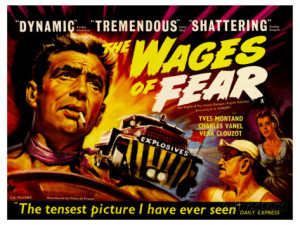
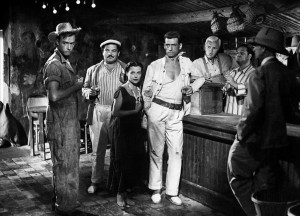
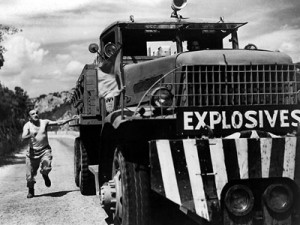
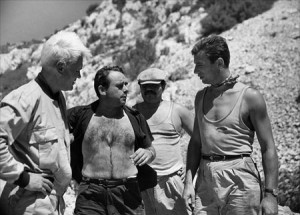
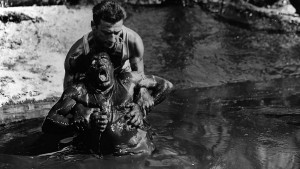
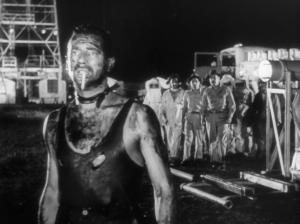
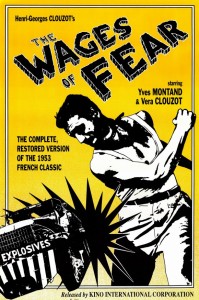
Pingback: #119 The Wages of Fear/Le salaire de la peur – 1000 Films Blog